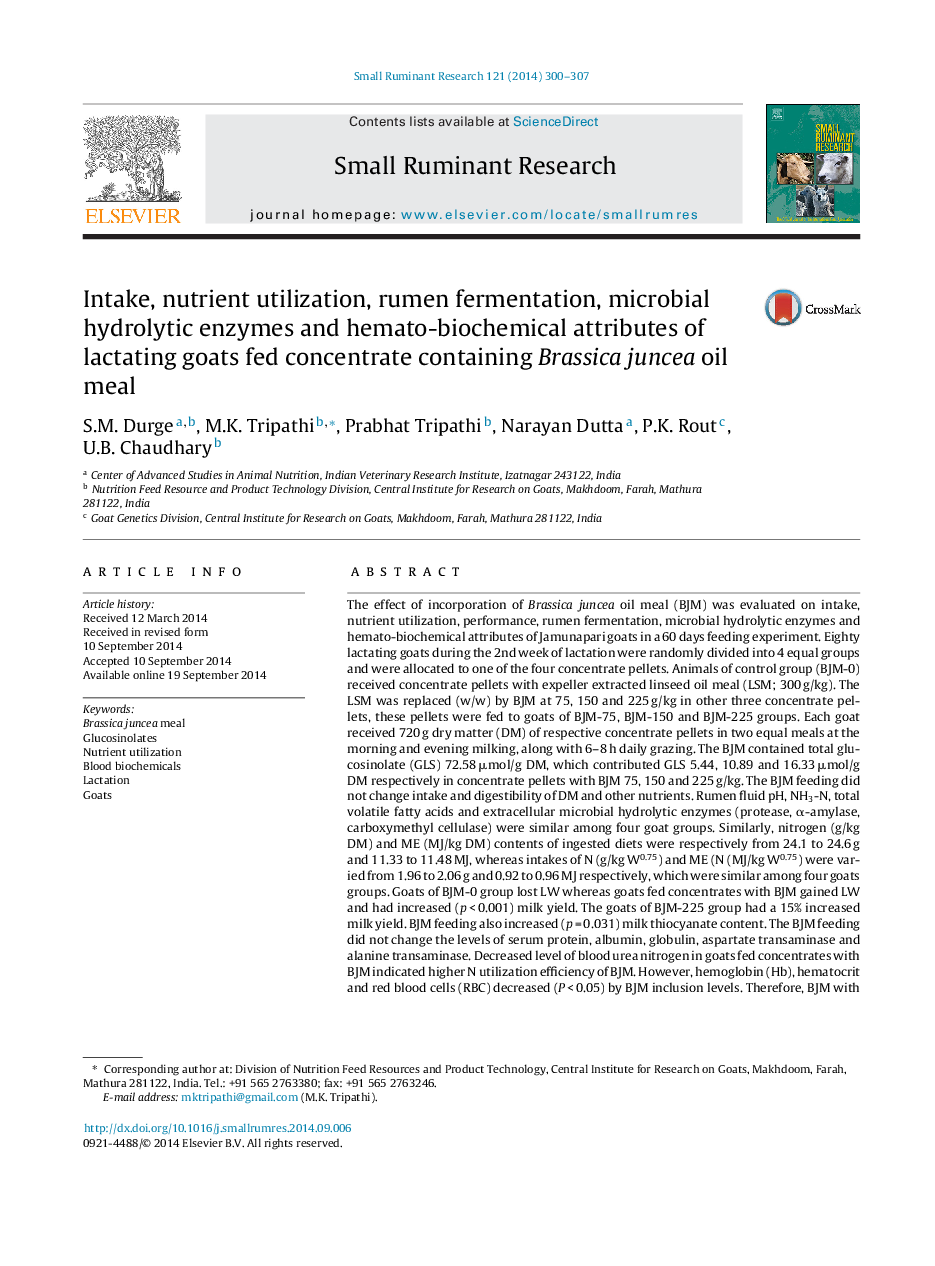| کد مقاله | کد نشریه | سال انتشار | مقاله انگلیسی | نسخه تمام متن |
|---|---|---|---|---|
| 5795561 | 1554371 | 2014 | 8 صفحه PDF | دانلود رایگان |
- Study evaluated Brassica juncea oil meal (BJM) as a cheaper protein feed in Goats.
- BJM feeding not affected intake, digestion, fermentation and rumen microbial enzymes.
- Goats fed BJM improved milk yield and reduced blood urea nitrogen indicated better N utilization.
- BJM with 72.58 μmol glucosinolates/g could use in concentrates up to 225 g/kg.
- Goats tolerated a daily intake of glucosinolates 11.76 mmoles or 9.45 μmol/g diet DM.
The effect of incorporation of Brassica juncea oil meal (BJM) was evaluated on intake, nutrient utilization, performance, rumen fermentation, microbial hydrolytic enzymes and hemato-biochemical attributes of Jamunapari goats in a 60 days feeding experiment. Eighty lactating goats during the 2nd week of lactation were randomly divided into 4 equal groups and were allocated to one of the four concentrate pellets. Animals of control group (BJM-0) received concentrate pellets with expeller extracted linseed oil meal (LSM; 300 g/kg). The LSM was replaced (w/w) by BJM at 75, 150 and 225 g/kg in other three concentrate pellets, these pellets were fed to goats of BJM-75, BJM-150 and BJM-225 groups. Each goat received 720 g dry matter (DM) of respective concentrate pellets in two equal meals at the morning and evening milking, along with 6-8 h daily grazing. The BJM contained total glucosinolate (GLS) 72.58 μmol/g DM, which contributed GLS 5.44, 10.89 and 16.33 μmol/g DM respectively in concentrate pellets with BJM 75, 150 and 225 g/kg. The BJM feeding did not change intake and digestibility of DM and other nutrients. Rumen fluid pH, NH3-N, total volatile fatty acids and extracellular microbial hydrolytic enzymes (protease, α-amylase, carboxymethyl cellulase) were similar among four goat groups. Similarly, nitrogen (g/kg DM) and ME (MJ/kg DM) contents of ingested diets were respectively from 24.1 to 24.6 g and 11.33 to 11.48 MJ, whereas intakes of N (g/kg W0.75) and ME (N (MJ/kg W0.75) were varied from 1.96 to 2.06 g and 0.92 to 0.96 MJ respectively, which were similar among four goats groups. Goats of BJM-0 group lost LW whereas goats fed concentrates with BJM gained LW and had increased (p < 0.001) milk yield. The goats of BJM-225 group had a 15% increased milk yield. BJM feeding also increased (p = 0.031) milk thiocyanate content. The BJM feeding did not change the levels of serum protein, albumin, globulin, aspartate transaminase and alanine transaminase. Decreased level of blood urea nitrogen in goats fed concentrates with BJM indicated higher N utilization efficiency of BJM. However, hemoglobin (Hb), hematocrit and red blood cells (RBC) decreased (P < 0.05) by BJM inclusion levels. Therefore, BJM with 72.58 μmol GLS/g DM could be incorporated in the concentrates up to 225 g/kg. Lactating goats in present experiment tolerated a daily intake of GLS 11.76 mmole, which amounted 9.45-μmol GLS/g diet DM. However, goats fed concentrates with BJM reduced blood Hb, RBC and hematocrit, and these observations needed further investigation.
Journal: Small Ruminant Research - Volume 121, Issues 2â3, October 2014, Pages 300-307
